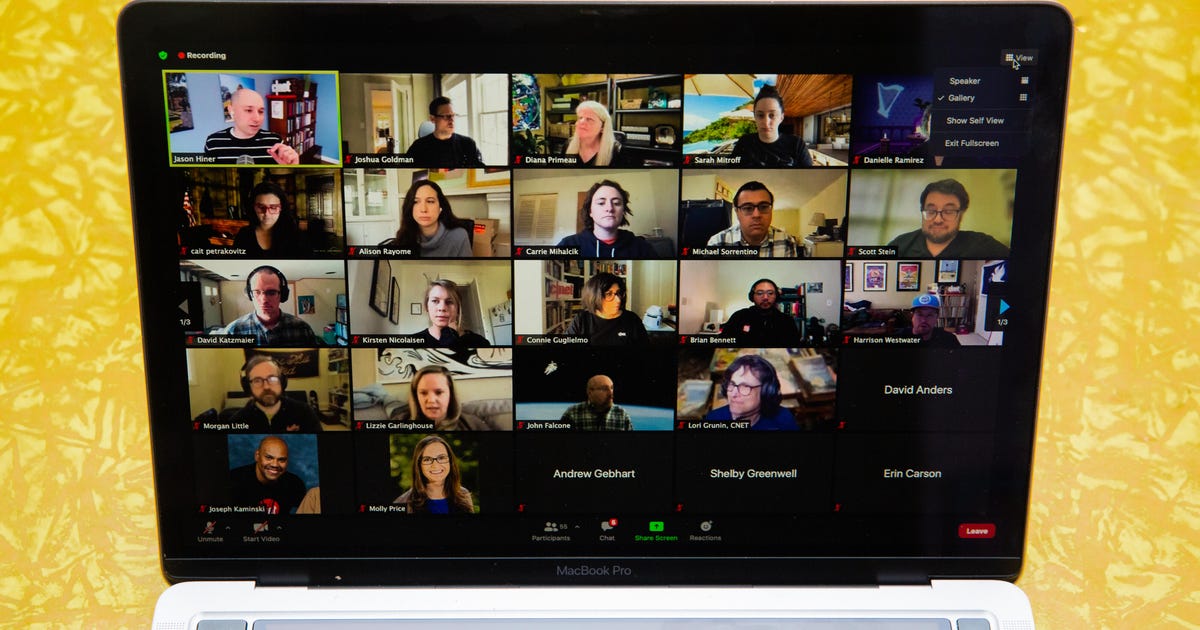
Zoom anxiety lingers even a year into the WFH era
This story is part of a series on life one year into the pandemic. Make sure to read part two: Zoom anxiety is real. Here's how to combat it . We've also got stories onwhy COVID may have changed our habits forever, andhow the pandemic gives health care workers a chance to shine on social media.
When coronavirus lockdowns began a year ago and much of the world turned to Zoom and other video chat services for work and socializing, Amanda Stevens, a project manager for New York state, found herself with a couple of very specific anxieties about her work-from-home video meetings. One was fighting the urge to fix her hair all the time, now that she was spending hours on end staring at her own reflection. The other? "My very old dog is prone to loud, unpredictable flatulence and I live in fear of it being picked up by my mic... and it not being attributed to my dog," she said.
One year into the pandemic, video chat platforms have afforded many people the ability to work from home and stay connected with family and friends. We've heard a lot about "Zoom fatigue" -- the sense of utter exhaustion you feel after a day of staring at your screen for on-camera meetings, worsened when most of your after-work socializing is happening through video, too. But the related concept of "Zoom anxiety" has gotten less attention, though it can be more debilitating for many -- and have potential career implications.
Few studies on Zoom anxiety exist, but a November survey of 2,000 home workers found that it stems from several sources: having tech and audio problems that you can't fix; being unable to read people's body language; feeling like you aren't being heard; having to take a call without time to prepare your appearance; worrying about an unprofessional background; and being talked over. (To be clear, in this story I'm using Zoom as a stand-in for all video chat platforms, since it essentially became a verb for video calls in 2020.)
"When you're face-to-face, you can pick up on a lot of things unconsciously in people's body language -- you notice if someone isn't reacting well, or if someone looks a bit uncomfortable," said Libby Sander, assistant professor of organizational behavior at Bond University in Queensland, Australia, who is studying the psychological effects of working from home. "You can get cues about when to interject into a conversation, and whether or not to pursue a particular line of discussion based on reading the room. It's pretty difficult or even impossible to do that on Zoom."
Even as vaccines are rolling out nationwide, the pandemic and moving to working from home are spurring many companies to create a hybrid workforce, where people split their time between home and the office -- which means video conferencing is likely here to stay. But if you suffer from anxiety using these on-camera tools, know that you're far from alone.
Read more: How to use Zoom Escaper, a sneaky tool for sabotaging your video calls
'The nightmares followed'

Zoom anxiety can come from having strangers see your space.
vgajic/Getty ImagesVivek Wadhwa, a distinguished fellow at the Harvard Law School Labor and Worklife Program, does a lot of TV appearances through Zoom. Once, he had to quickly change a shirt before an interview, and did so without realizing the camera was on. Luckily he wasn't on air, but it was a close enough call that "the nightmares followed," he said.
"Remember the 'college dream' or 'examination dream' in which you're late for class and miss the exam, or you can't find the classroom, or studied the wrong subject?" Wadhwa said. "The new 'college dream' is when you forget to change out of your pajamas before going on Zoom."
At the start of the pandemic, Caroline Jo, a brand marketer in Orange County, California, would dress up for video meetings, wear makeup and play around with Zoom filters. But as time went on, the energy that went into these meetings became draining, and she found herself riddled with stress and unable to sleep the night before days packed with video calls.
"I'm a marketer, and marketers are stereotypically known to be the vivacious, outspoken bunch, but I am keenly introverted and introspective, which I do believe are still very valuable to work," Jo said. "However, when it comes to Zoom meetings specifically, the anxiety comes from even the most basic things -- awkward silences, the game of 'who should speak next?', the constant attention, the forced small talk, and technological snafus like audio issues or being bold and speaking up yet realizing I was on mute the whole time."
These stressors can arise outside of the workplace, too. Kristen Taylor Hunt, an artist from Louisville, Kentucky, started avoiding her therapy sessions when they moved to a video chat format. "I often can't concentrate on what's actually happening or being said because I'm worried about if my reactions look genuine, or do people think I don't care about what's being said because I look bored or angry," she said. As a person with multiple autoimmune diseases, "COVID has really taken a toll on my mental health ... I really need to be in therapy."
Social video chats can also trigger stress. When you see friends in person, you don't feel the same pressure to "perform socially" that you do on video chat, Suzanne Degges-White, a professor and chair of the counseling and higher education department at Northern Illinois University, pointed out in a Psychology Today column. Just being present in the same space is enough. But on video, you're more likely to feel like you have to be constantly talking or entertaining in some way -- otherwise, you're just sitting there smiling at the camera.
Career opportunities and the gender gap

Women typically have more trouble being heard during meetings than men, and video conferencing can make this worse.
FilippoBacci/Getty ImagesSome aspects of Zoom anxiety appear to be gendered. A number of studies have shown the gender inequities present in in-person meetings and group settings. Generally, men are viewed as more competent for speaking longer, while women are viewed as less competent for doing the same. Women are also far more likely to be interrupted or spoken over. These issues are exacerbated over video chat, Sander said, and women may struggle to get chances to get across their point of view.
One small 2017 study examined women's gaze during Skype video calls and found that those who were socially anxious spent more time looking at their own image -- particularly if the person they were speaking to was being critical of them.
Video chat platforms also tend to reward those who are the loudest, since that's whose voice will get picked up. And when you have that awkward moment where two people are talking, the lag can make it difficult to circle back to the other person, Sander added.
Outside of the talking elements, many women have also reported feeling stressed and being apologetic over their appearance on camera, while men tend to worry less about how they look or what they're wearing. Jason Sudeikis wearing a hoodie to accept his Golden Globe award via Zoom, compared to the full makeup and evening gowns of most female nominees, is a pretty solid example of this.
For people across the gender spectrum, working from home can offer fewer opportunities for building professional relationships, especially if you were new to a job when the pandemic hit. Your work may be less visible to your manager, and you have fewer opportunities for casual discussions that arise in an office environment about the work you're doing or any problems you're having, Sander said.
"We'll have to wait and see how it plays out in terms of career progression, but right now people are most concerned about health and safety, and the continuity of business and having a job," she added. "But I do think there are big issues we have to be aware of."
Source


